I have recently been trying long exposure photography and I immediately hit on a problem – a equipment related problem.
The main trick with long exposure photography is that the camera is securely mounted and an exposure is taken which can range from a few seconds to minutes and hours. Mounting the camera is not an issue for me as I invested in a very good tripod and ball head several years back. However, even with the best tripod that money can buy you still get some flexing and vibrating especially when you are punching at the shutter button.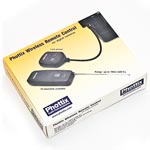
Luckily most cameras have the ability to remotely actuate the shutter with a corded release, and some even let you auto-focus. My previous camera, the Nikon D70 enjoyed the ability of using an infrared remote shutter control – which was great as I could even use my PDA as a remote control.
My current camera, the Nikon D200 does not use infrared but does allow remote control through Nikon’s 10 pin accessory socket. As I was searching through the various remote shutter cords on Ebay, I noticed this wireless Phottix remote shutter control. A buy-it-now later for a grand total of £13.40 I had one shipping it’s way over to me from Hong Kong.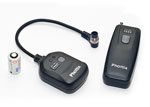
Over last couple of years these cheap non-oem camera accessories have been getting better and better, so I was hoping this was one of the better items. Original manufacturer accessories tend to be better quality but the quality difference in most cases cannot justify the ridiculous pricing structure. Take for example a simple remote shutter cord – the original Nikon costs over £55 here in the uk, the cheapy equivalent costs £6 – they both follow the same concept, 10pin Nikon connector on one end with a two level switch on the other, both do exactly the same thing but 10 time the price difference.
Description
Rant over, getting back to the Phottix remote. It comes ready to use out of the box, batteries are included even the expensive 3v CR2 for the receiver. The remote consists of two parts, the transmitter and the receiver unit.
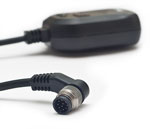 The fit and finish of the units is excellent. The outside of each unit has a row of 4 dip switches which sets the code to be used between the devices.
The fit and finish of the units is excellent. The outside of each unit has a row of 4 dip switches which sets the code to be used between the devices.
The receiver has two leds, one is used to show that receiver is switched on and the other is used to indicate the received signal – green for auto-focus and red for shutter actuation. The Nikon connector appears to be of a good quality even including the metal locking ring which is not normally seen on these non-oem accessories.
 The transmitter has the release button which when pressed lightly activates the auto-focus and a hard press actuates the shutter, similar to how the shutter button works on the camera. The button has no tactile feedback, thankfully there is an led which indicates what is happening using the same method as the receiver – green for autofocus and red for shutter release. The transmitter does not have a on/off button, so I assume it only draws current when the button is pressed.
The transmitter has the release button which when pressed lightly activates the auto-focus and a hard press actuates the shutter, similar to how the shutter button works on the camera. The button has no tactile feedback, thankfully there is an led which indicates what is happening using the same method as the receiver – green for autofocus and red for shutter release. The transmitter does not have a on/off button, so I assume it only draws current when the button is pressed.
Installation
Installing is very easy, just a matter of plugging the receiver in to the camera and switching it on. Make sure the dip switches are set the same on both units and then you are good to go.
Usage
After a week of using the wireless remote, I must say I have been very impressed. In photography the most important thing for me is that the equipment is transparent and does not hinder or get in the way of what I am trying to do, and here the Phottix has performed well it has not missed a beat.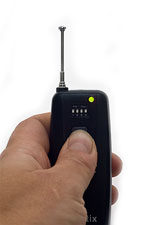
I carried out some basic range testing and with the transmitter antenna retracted I achieved about 15 meters of usable distance, with the antenna pulled out I achieved about 50 meters before I ran out of space – not sure if the device can be used over the manufacturers claimed 100m (300 ft) but I would think the 50m I achieved is more than enough for most people.
The unit even has a bulb mode – the B mode is found on some camera, this allows you to keep the shutter open as long as you want (or till the battery run outs), the shutter is kept open as long as you keep release button pressed.
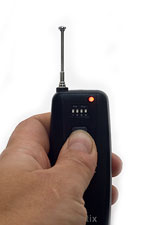 For a 30minute exposure that will mean some serious finger ache, but thankfully Phottix have included a latch mode (or B-mode in marketing speak). Once you have set your camera to Bulb mode – on my D200 you select manual shooting mode, and then adjust the shutter speed till it displays – bulb. When you are ready to start your exposure you press the release button on the transmitter for about 3 seconds till the shutter led turns off – now the shutter is latched open. After the required exposure time another press on the transmitter button releases the shutter.
For a 30minute exposure that will mean some serious finger ache, but thankfully Phottix have included a latch mode (or B-mode in marketing speak). Once you have set your camera to Bulb mode – on my D200 you select manual shooting mode, and then adjust the shutter speed till it displays – bulb. When you are ready to start your exposure you press the release button on the transmitter for about 3 seconds till the shutter led turns off – now the shutter is latched open. After the required exposure time another press on the transmitter button releases the shutter.
Conclusion
For the price I was actually surprised it worked as well as it did. During my virgorous testing I did notice areas where shall we say there is room for improvement.
The release button is very poor – there is no tactile feedback, worse still no feedback between the half-press and full-press. Without the led indicator you cannot tell if you have started auto-focusing or if you have actuated the shutter. I took the transmitter apart to inspect the switch, and what I found is not really a switch more a science experiment that is done by 10 years old at school – 3 springy pieces of metal are pushed in to each other to act as switches.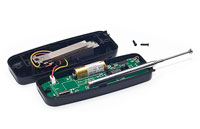
This arrangement also explains another problem I found – it is very easy to accidentally actuate the shutter several times when pressing the button, in electronics terms this is called switch bounce. To get round switch bounce, in your circuit you design in a de-bounce circuit – the point of this circuit is to clean up the signal coming from the switch, it is a timing circuit and is generally designed using the maximum time the switch takes to settle. Most good quality switches tend to settle in about 1mS and some even faster, but I can imagine the switch bounce in this unit is very bad and it appears that the circuit just cannot deal with it – so you end up with a shutter release which has built-in jitter.
My final disappointment is that the receiver needs a battery. Nikon’s 10pin connector can supply power to accessories, so why did they not power the receiver from the camera? – it would make much more sense as well as reducing the cost to the manufacturer.
 This product is not just a review item for me, I actually use it and I have decided to do some modifications – replace the switch with one from a old camera, and rewire the connector so the receiver can be powered by the camera. I will write a how-to article describing the modifications in detail.
This product is not just a review item for me, I actually use it and I have decided to do some modifications – replace the switch with one from a old camera, and rewire the connector so the receiver can be powered by the camera. I will write a how-to article describing the modifications in detail.
In closing, the unit does what it is designed to do, and in most parts it does it well. I would suggest everyone who takes photography seriously to consider having one in the camera bag – it can also be great fun trying out long exposure photography. For the price it is very easy to ignore the downsides, just remember how much the OEM equivalent costs!!!
-
Cheap and good quality
-
Metal locking ring on connector
-
Excellent wireless range
-
Bulb mode
Con’s
-
Poor quality shutter release button
-
Receiver should be powered by camera


Pingback: Phottix Wireless Remote Control | Fotogrado
Pingback: Hakkı Ceylan » Phottix Wireless Remote Control
I can tell you why the receiver is not powered by the camera. It would actually cost the manufacturer MORE to do that, not less as you estimate in your review. They make 6-8 “different” versions of this remote, but in reality they are all the same. The only thing that makes them different is the cable that attaches to the camera. Most cameras do not do provide power to accessories, mine included (Konica Minolta 5D). If they made truly unique models for each camera, they would cost more. In fact, I consider this as a bit of a pro for this remote (or at least the newer model I bought, the picture of yours looks as if the wire is permanently attached). If you have multiple cameras, or get a new one of a different brand, you don’t have to get a new remote, just a new cable.
Anyway, I bought the newest model of wireless remote they have available, the Plato. This one apparently is a big improvement over the model you reviewed. It uses standard AAA batteries in the remote and receiver instead of the expensive and sometimes hard to find lithium ones. Mine has very good feedback from the shutter button. There is an audible click, and you can feel the switch settle at half press, then the button requires a good bit more pressure to press fully, when there is another audible click. The click isn’t very loud, quieter than the shutter in the camera, buy it is audible. The remote and the receiver both have the red and green lights as you mentioned in your review. The Plato goes another step further though. It has two way communication between the remote and receiver. There is a second LED on the remote that duplicates the one on the receiver. You can see if the receiver got the signal or not by watching the remote. I suppose it would be possible, although unlikely, that the receiver got the signal and operated the camera, but the remote didn’t receive the feedback signal. If the second LED didn’t light, you are probably out of range. Also, the Plato does not have an antenna to pull out and possibly break off, but it still has good range.
The Plato also has 4 modes for the button. It has a standard shutter button mode, no explanation needed. It has a 2S mode, where you can press the button, and there is a two second delay before the receiver triggers the shutter. This allows you to be in the picture, and gives you time to hide the remote. You don’t have to set the camera to do this, a simple button press on the remote sets this up. It has a “continuous advance” mode, although this is a bit different that what the camera calls continuous advance mode. My camera (I’m sure probably most do) has a mode where it will take pictures ass fast as it is capable of as long as you hold down the shutter. The Plato has a mode where one press of the button on the remote triggers the camera 5 times at one second intervals, without changing any settings on the camera. The last mode is the bulb mode similar to what you mentioned, except that you don’t have to hold it down for 3 seconds. One full press turns it on, another turns it off. It works with long exposures and with the camera’s built in continuous advance mode. Continuous advance this way works exactly as it would if you were using the camera’s built in shutter button.
Another nice thing about the Plato is that it works in both wired and wireless mode. The wire that attaches the receiver to the camera has a plug on the receiver end similar to the mini headphone jack we are all familiar with used with computer speakers and headphones for iPods, etc. If you plug the cable into the receiver, it works wirelessly. If you don’t need to be wireless, you can plug the cable directly into the remote, and it works as a wired remote with about 20cm of wire.
The Plato also does away with the dip switches for pairing the remote and receiver. It uses built in rolling digital codes much like a modern cordless phone or garage door opener for security. You can even reset the remote/receiver link if you have more than one camera and remote. One remote can simultaneously fire I think as many as 16 million cameras theoretically if you reset the link on that many receivers and you would want to do that. I could see that someone might want to do that with a few cameras to get multiple views of the same scene.
The Plato is available from ebay, seller name Hong Kong Supplies, just like the remote you reviewed. I bought mine for US$45 including shipping. Go to ebay, search for “plato remote” and you will get around 100 or so listings. They are all from the same seller. Look for the one that matches your camera. They have C6 for some Canons, Contax, Pentax, and Samsung, C8 for other Canons, N6, N8 and N10 for Nikons (N8 also works some Fujis and Kodaks), S6 for Sony/Minolta, O6 for Olympus, and P6 for Panasonic. Click on the listing for any one of them, and scroll down the page. There is a fairly complete listing of all the cameras that are compatible and which cable goes with each camera.
Hi Tarkan
Thaks.
Hi Tarkan:
I left my phottix on and the batteries appear to have drained. Are the batteries hard to replace?? Thanks. W
Only place I know is Ebay – but if you want I can sell you one of mine, I bought two and now one is not needed.
I want info on where to purchase the phottix remote. Please do not send me to EBAY.
I am glad you enjoyed the article – sadly time has not been on my side.
Hopefully time permitting I maybe able to get something up in the next 3 weeks.
I found your article very interesting about the Phottix Wireless Remote, and was wondering when you were going to write an article on the modifications you menioned.
regards Lyndon